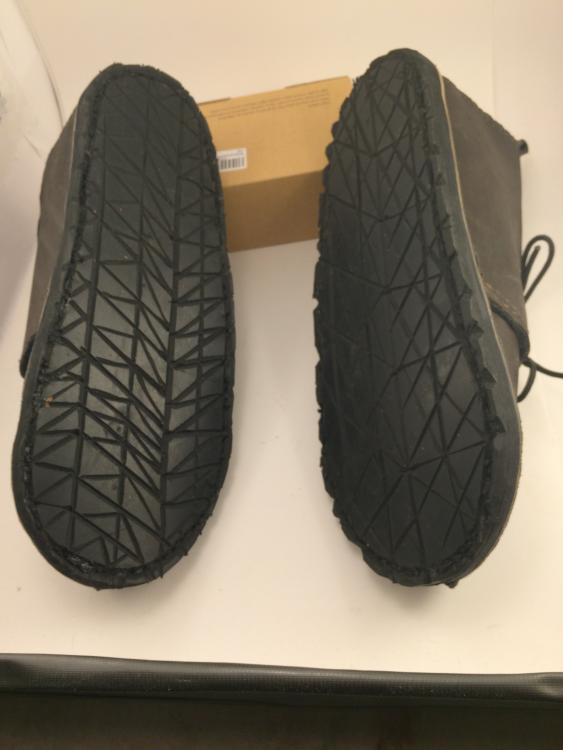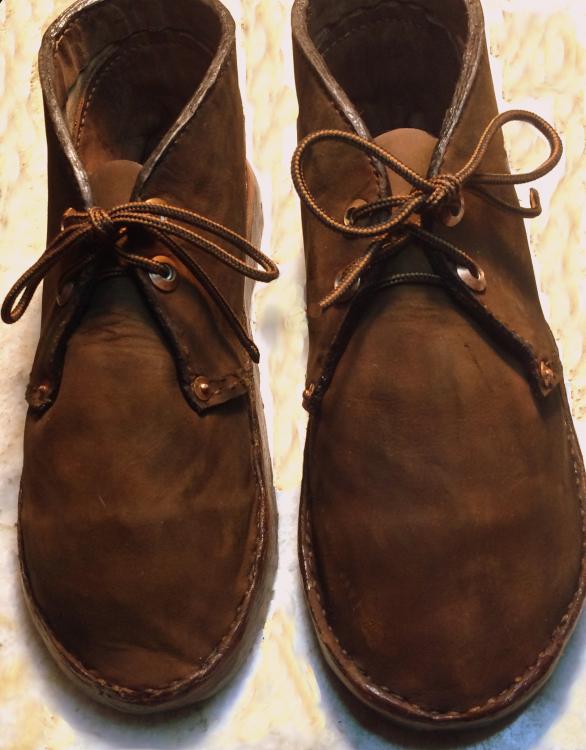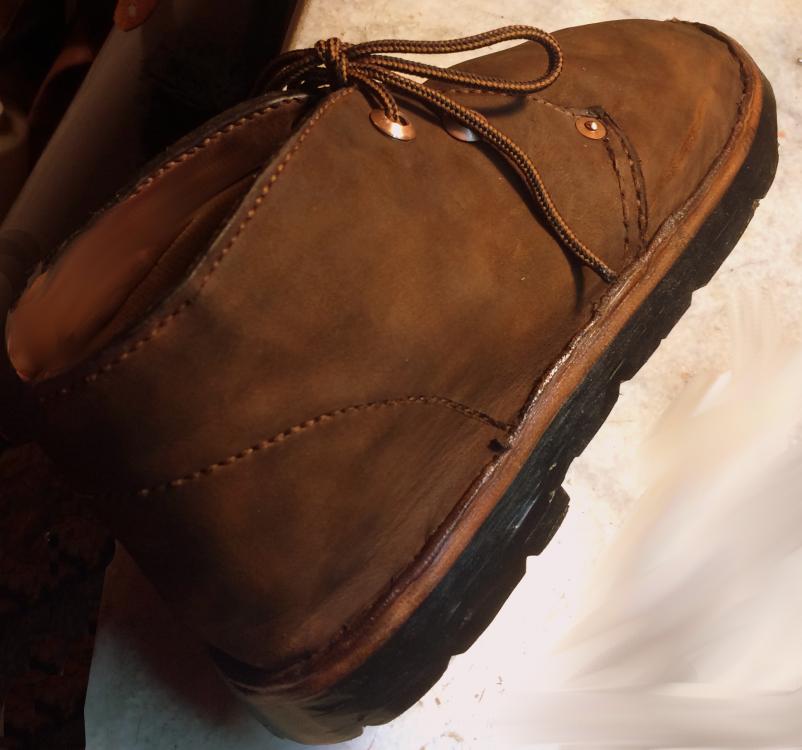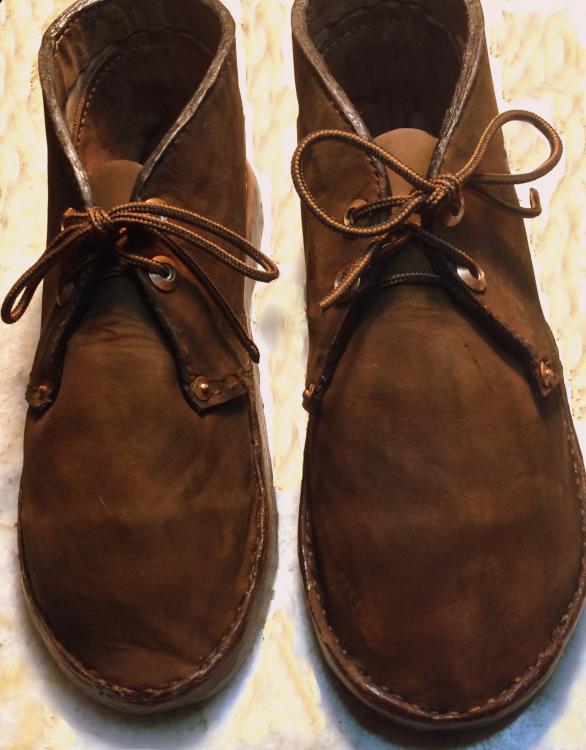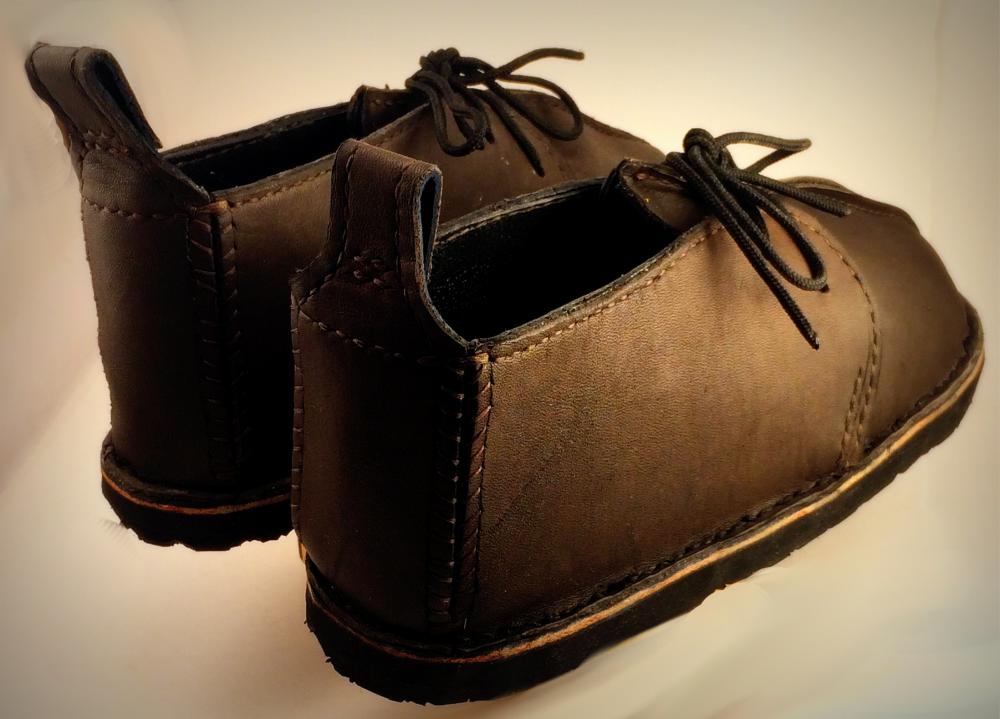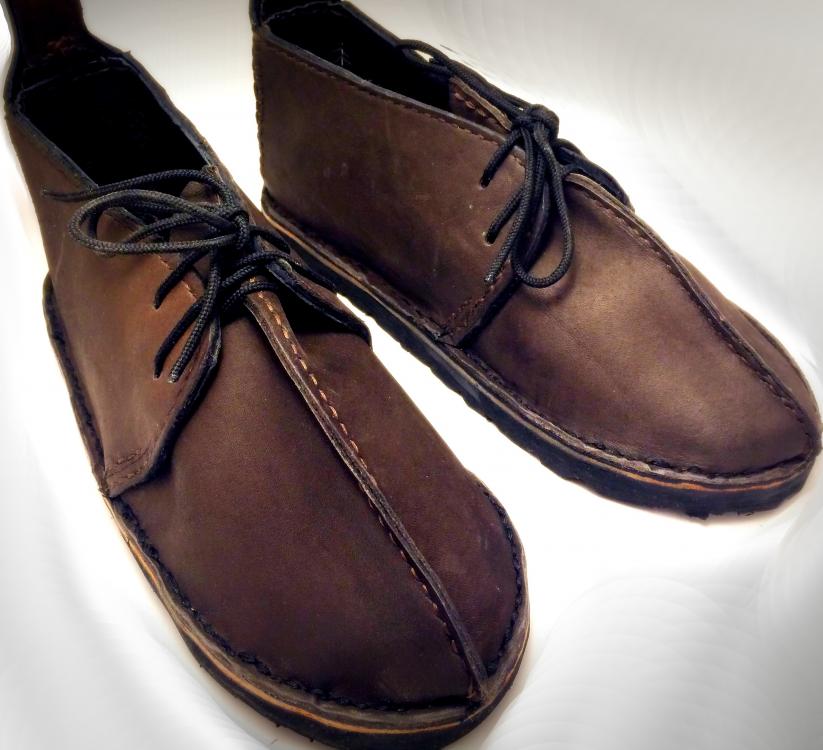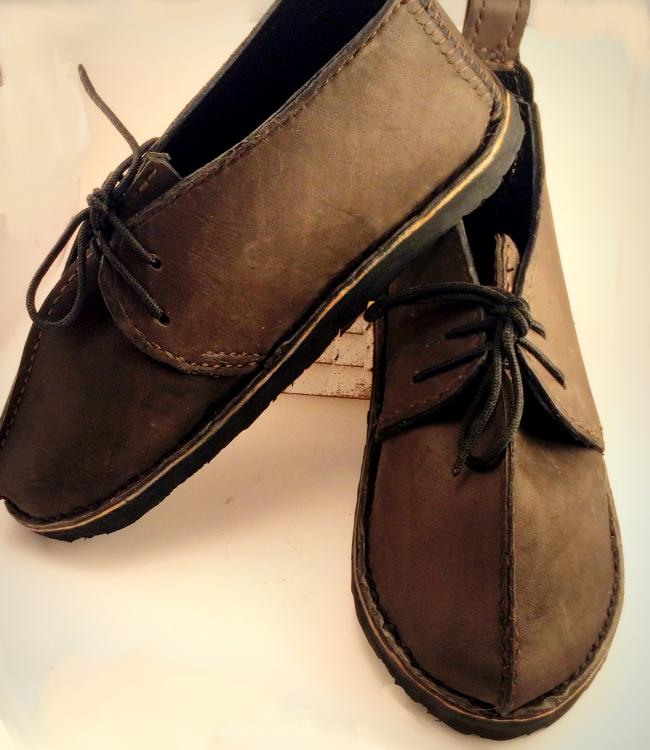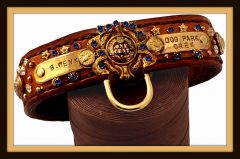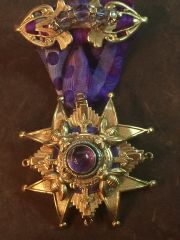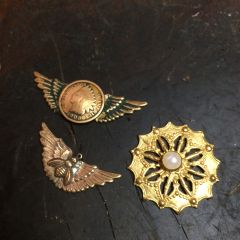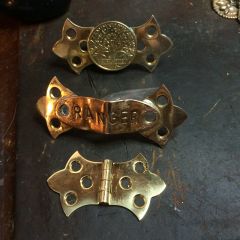-
Posts
444 -
Joined
-
Last visited
Content Type
Profiles
Forums
Events
Blogs
Gallery
Everything posted by Reegesc
-
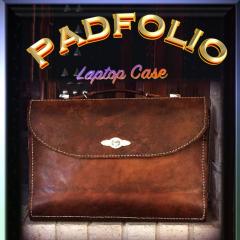
Finally Cracked the Shoe Code
Reegesc replied to Reegesc's topic in Shoes, Boots, Sandals and Moccassins
Yessir, Desert Treks and Desert Chukka./ Nothing special to tell you the truth. I've tackled that style many times. I've used thick shoulder leather, cork, conveyor belting. Have layered in staggered lengths to get that wedge look. For both styles I bought used Clark's shoes took them apart and they are just as simple as can be. Nothing under the hood worth mentioning. Everything you need to know can be had with an external look. PM me if you're interested in a template- 10 replies
-
- chukka boot
- chukka
-
(and 2 more)
Tagged with:
-
Yeah, that's a good point. The Chinese 1mm does feel and look more like .8 mm. Earlier I had said that there wasn't enough difference between all three to worry about it. but that it is a pretty big difference. The more I use the Double Eagle, the more I like it out of all three. It's my go to thread now.
-
Here's a "thread" you might be interested in. Your shop looks terrific. The only thing that could possibly be better is if you could drive your truck into it.......well that and maybe a living area and full service bar.......and perhaps a makeshift kitchen with a wood fired pizza oven and an infrared steak grill......and extra wide permitter aisles so you could roller skate around the whole thing whenever you felt like it. But, ya know, chasing that last 1%? I tell ya, you never get there. I wish I would have stopped right after the full service bar.
-
They sell skirtboard in all sorts of dimensions. I just took a look at that site and they offer 3/8" @ $1.29/ft which works out to $65 for a 50' roll. https://www.mrosupply.com/rubber/skirt-board-rubber/1695556_6341-1205_jason-industrial/ I don't see why you couldn't split the 1/4". Haven't tried this, but it cuts so easily and evenly I'd bet you could split it if you had a bench splitter. I know you you can sand it down on a belt sander and even here it is easier to work with than leather. Getting a nice even thickness would be challenging on a belt sander, however. But I dunno, maybe if you made yourself a jig? Both sides are the same -- super smooth, very flexible, dense rubber. Residue isn't an issue in normal use or normal handling like cutting out the soles or gouging out a tread and wearing them. I'm referring to hand sewing which requires constant handling for three hours straight, turning it over and over. That's where you'll get residue build up from the sweat and oils off your bare hands mixing with the rubber. Mind you, it's not like it turns your hands black. You hands just get dirty and you don't want that transferred to your leather. This is an issue handling leather in general. How many veg tan pieces have you dorked up handling and working it with your bare hands? I've hosed up my fair share. A lot of toolers wear nitrate gloves for this very reason. I'm fairly certain there aren't hidden issues with this material because it was the material of choice by moccasin makers back in the day before eBay monetized everything . For years moccasin makers would go to factories and get used belts for free. There is a couple citations here on the forum in fact. I got all excited when I found this secret while hunting for a low cost rubber soling material only to discover that it isn't a low cost option anymore. This deal is exceptionally low. Maybe it's an overstock situation, I don't know, but it's so low that I'm inclined to get another roll before it disappears. To tell you the truth, I've been considering selling it myself. Any takers? $5 a pair + shipping. I'll even throw in a cardboard template of the size of your choice.
- 131 replies
-
- flip flops
- pattern
-
(and 2 more)
Tagged with:
-
It does look nice but how can you call it a shop when everything is so easy to find and use? Maybe you meant showroom?
-
Man, look at that! Clever...
- 4 replies
-
- lid
- saddle stitch
- (and 5 more)
-
I love this stuff for soling material. This is rubber conveyor belt material otherwise known as "Skirtboard". Flexible, durable (well, time will tell but it sure looks durable)....it even has a perfumey smell if you can believe that. It is joy to work with. It is substantially easier to work with than leather. It's easier to cut, it's easier to groove, it's easier to stitch. Cutting a tread is easy as can be using your V Groove tool or French Skiver or similar tools. https://www.mrosupply.com/rubber/skirt-board-rubber/1695546_6341-0805_jason-industrial/?utm_campaign=Order-Acknowledgement-Auto&utm_source=Transactional-Email&utm_medium=Email Wear nitrate gloves while hand sewing the uppers to the rubber outsoles to minimize transferring black rubber residue on your leather. You'll still get some residue on the gloves, but far less than your bare hands. Just keep an eye on it and put on a new pair when it begins to build up. Sadly, few of you are going to go with my recommendation. A 50' roll is just ridiculous you'll say. All you want is enough to make a couple pairs. Fine. Go out there and price outsoles by the pair. The first thing you'll notice is there isn't much of a selection and what is available is expensive. Here's an offering on Etsy that's attractive: precut, prepunched, lots of colors, for a quality brand sole (Vibram). Perfect except it's $15 a pair. https://www.etsy.com/listing/203119955/vibram-rubber-soles-for-slippers-and?ref=market For soling material by the sheet, you're pretty much limited to Duratec Rubber Soling Sheets. Here's one for an 8" x 20" sheet, enough for one pair @ $4.50 but it's paper thin at 1.4mm thick. https://www.etsy.com/listing/204559109/duratec-rubber-soling-sheet-8-x-20?ref=market Now take another look at my suggestion. $40 for a 50' roll and shipping is free. You first pair costs $40. The second pair $20. Make ten pairs and your cost is down to $4. Use it all and your cost is $1.60 pair. Maybe you have a friend who will split it with you? Maybe you discover that you could use a conveyor belt to move dirty clothes from the hamper to the washing machine? However you rationalize it, you'll not be disappointed with this soling material.
- 131 replies
-
- flip flops
- pattern
-
(and 2 more)
Tagged with:
-
I don't suppose you wear a size 9, do you? I made these as a surprise gift for a friend whom I visited just this last weekend. Imagine my surprise discovering he is a size 10. These boots are looking for a new home where they will be loved and worn. If these don't work for you, the offer is extended to anyone else. The boots are free but you pay shipping.
-
Boy ain't that the truth. Just how much did those flops end up costing you when it's all said and done with? This is one area where it's better being a hobbyist than a pro in the business because you have several different ways to figure out how much those flip flops cost you whereas the pro only has one and it ain't the one you want, trust me. There's the Finished Project Incremental Method where you only add up the cost of supplies and materials that you had to purchase to make the pair you are satisfied with. For example, if you didn't have to buy anything beyond what you already had on hand, the cost is zero. Free flops. This is the recommended costing approach, particularly if the answer is "Zero." Then there's the Learning Curve Incremental Method where you add up the cost of supplies and materials (and tools if you bought any) that you actually incurred starting with your first attempt and all subsequent attempts clear through your final attempt. You still might come out on the low end, even zero cost is possible. Then there's the Full Absorption Method which is the only method available to those in biz. This is NOT a recommended costing approach for hobbyists, particularly those with heart issues or nagging spouses, as it is a truer reflection of actual cost and it will be a MUCH higher figure than the previous two methods. With the full absorption method you factor in the cost of all your tools (depreciation) and not just dedicated leatherwork tools, ANY TOOL. You also factor in the cost of all the materials and supplies used, from first attempt to finished project, regardless of when purchased, plus an allowance for scrap and waste using "first in first out" pricing . If you have a dedicated workspace, you add the cost of that space on pro rata basis -- that includes utilities, taxes, insurance in addition to rent or depreciation if you own the facility. Most businesses would stop there, but to be truly accurate, include the cost of all the beverages you drank from the workshop fridge to keep you going late into the night even if they were responsible for failed attempts. Don't blame the beer! Plus factor in the opportunity cost of a foregone second job in lieu of putzing around for hours on end in your workshop instead. Also, add the cost of pain and suffering if you whack your fingers with a cobbler's hammer, jab a needle in your hand, or take a knife nick. Also account for how much you would have had to contribute if you were held to a Mandatory $1 Cuss Jar. Truth is a relative thing. It's up to you, but most people would prefer to honestly say "Next to nothing" instead of "A little under a grand" when asked how much it cost to make those fine looking flops you're wearing. Stick with the first two methods and you could pass a lie detector test and come off like a rational, logical human being. Go with the third method and no matter how awesome the flip flops are you will be immediately branded a nut. Just saying...
- 131 replies
-
- flip flops
- pattern
-
(and 2 more)
Tagged with:
-

Finally Cracked the Shoe Code
Reegesc replied to Reegesc's topic in Shoes, Boots, Sandals and Moccassins
;-) Hey Grey....- 10 replies
-
- chukka boot
- chukka
-
(and 2 more)
Tagged with:
-

Finally Cracked the Shoe Code
Reegesc replied to Reegesc's topic in Shoes, Boots, Sandals and Moccassins
What's a toe box? Yeah, they were lasted, sorta. You'll just have to wait for my tutorial (and however long it takes me to figure out the toe box thingy).- 10 replies
-
- chukka boot
- chukka
-
(and 2 more)
Tagged with:
-

Finally Cracked the Shoe Code
Reegesc replied to Reegesc's topic in Shoes, Boots, Sandals and Moccassins
Ok electrerathon, I hear you loud and clear buddy. A tutorial you shall have. hahaha :-) twist my arm....- 10 replies
-
- chukka boot
- chukka
-
(and 2 more)
Tagged with:
-
It's been over a month now and I've had plenty of experience using the Twin Eagle thread and the Chinese thread, that's in addition to having used Tiger Thread for over a year or so. The headline is I like them ALL! I don't think any of them is superior to the other. I really don't. Both the Chinese and Twin Eagle threads have less wax than Tiger thread but that doesn't mean they don't have enough. I think it just means that Tiger has an overkill amount of wax. I particularly like the size of the Twin Eagle at 1.2 mm. I'm just partial to big ol' fat thread I guess and it has become my go to thread. Check out these shoes I made. The Desert Chukka (the one with the plain front) was stitched using the 1.2 mm Twin Eagle Thread, even for the fine stitching. The Trek Chukka (The middle seam front) was stitched using 1 mm Chinese thread. You tell me....does either one look like second rate thread to you? No way. It's good stuff all the way around.
-
And it only took 20, maybe 25 attempts. But now? Hah, I can make pair whenever I feel like it. Free at last... If enough people beg me, I'll make a tutorial. Edit: Kudos Johanna, the new site looks terrific!
- 10 replies
-
- chukka boot
- chukka
-
(and 2 more)
Tagged with:
-
-
From the album: Misc
-
Thank you, but I'm glad you took the trial and error approach instead and used this as a reference. Not to get too Philosophical about it......oh, what the heck! Let's get Philosophical! Tutorials teach how to make a thing while trial and error teaches how to work with leather. That's a big difference. The fact is, if you get it right the first time? You haven't learned anything. But by the time you do get it right, you can make it and its cousin variants multiple ways. Not only that but there's a hidden bonus too. You get to write tutorials. ;-)
- 131 replies
-
- flip flops
- pattern
-
(and 2 more)
Tagged with:
-
That is a good deal. Thx
-

Funny/sad Story About Tandy Leather...
Reegesc replied to Dougster's topic in Leatherwork Conversation
~sigh~ -

Funny/sad Story About Tandy Leather...
Reegesc replied to Dougster's topic in Leatherwork Conversation
Ha, so you overcharged yourself and were shortchanged on acknowledgement of your generosity. Man, that's a full circle underage/overage transaction Geez. Just curious, why didn't you say something, to the Husband at any rate if for no other reason than to demonstrate you appreciated his generosity? As it stood, both of you were shortchanged on being good guys. You make a good point on overages though, that all things equal, intervening in an overage that's noticed is a double dip with nonintervention of an undercharge. I see your point, that if you isolate all observed overcharges and undercharges, you either have to be all in or completely out. Thinking this through a bit more, however, that doesn't take into account the seller's side of the equation, i.e., their actions on the observed errors. I think it's fair to say that at the register you would expect fair play 99% of the time (your Tandy experience being the outlier). But the dynamic is quite a bit different on the seller side. Whereas consumers are pretty much limited to observing these errors at the register and to a much lesser degree scrutinizing their sales receipt on the way to their auto, sellers have multiple reviews through their accounting systems and procedures. It's estimated that 5% of scans are in error and overcharges are upwards of $2.5B annually. So in the case of the seller, they discover these errors more frequently than consumers after the fact with aggregated systems and accounting information. I think that once it's removed from the register and is being examined analytically, the behavior is going to be a double dip and to take the windfall. And if true, then the balance would be the consumer doing the same. What do you think? -

Funny/sad Story About Tandy Leather...
Reegesc replied to Dougster's topic in Leatherwork Conversation
Yes, of course. I'm referring to accidental overages, underages. Theft is...well THEFT. Not much to discuss on that topic. Well, I guess you could explore what constitutes theft, but I got stuff to do. Maybe later. -

Funny/sad Story About Tandy Leather...
Reegesc replied to Dougster's topic in Leatherwork Conversation
Not dissing corporate at all. I have an MBA, plenty of conservative academic economics training, and 25 years in Fortune 500 corporate finance. I'm pro big bidness. Also not saying anyone has been malicious or at fault. These are just accidents that happen. I'm simply applying a statistical model to a common behavior and concluding that there is no ethical misconduct in accepting a windfall just as there is no ethical misconduct by foregoing overcharges --- overcharges you don't know about, and I can assure you we all have a lot more of those than we know. The reason I made a distinction between a big corporation and a mom and pop shop is simply because I elect not to include them in the "correction pool" because I'm a softy and they would be more directly and disproportionately affected. I would and have extended that people I've hired to perform house repairs and what not -- carpenters, electricians, laborers. Corporations aren't suffering from my "correction" practice. Quite the opposite. Overcharges are pure profit. -- More challengers please -- -
Yes it does make sense but I can't answer it. I use 1mm exclusively and don't think in terms of other sizes, inches or millimeters. But I tell ya what, PM me with your address and I will send you a generous sample of each -- the Chinese and the Twin Eagle (the Twin should be in a couple days). Seriously, take me up on it. Happy to help.
-

Funny/sad Story About Tandy Leather...
Reegesc replied to Dougster's topic in Leatherwork Conversation
It's interesting how the original post generated so many comments. But then again it's ethics + money and that's sure to garner interest. I popped in this thread thinking it was going to be humorous story. As it turns out I have something to add here that I'm going to share because I so rarely have the opportunity to present my theory on over/undercharging. It take a different approach than most people. But before I explain my theory, let me preface my practice by saying I only apply this to the faceless, corporate big box stores and not at the owner/operator one man locksmith shop. Just a couple days ago my friendly neighborhood convenience store owner accidentally gave me change back on a $20 when it should have been on a $10. That was returned on the spot without even thinking about it. Then there's the other stores.... It's only happened a handful of times, but if I'm checking out and I notice I have been undercharged, I don't point it out -- I take the "savings". Now, is that unethical? Hardly. These things happen on a normal distribution. The amount and number of times you are overcharged are balanced by an equivalent amount of overcharges that you don't notice and never find out about. The way I see it, I'm just keeping the overall over/under charge in balance over a lifetime of shopping. -- Debate Challengers Welcomed -- -
I'm glad I brought this thread back to life. A site buddy of mine, MonicaJacobson, recommends TWIN EAGLE THREAD She said "it seems almost exactly like Tiger Thread". Man I tell you what, judging by this picture, I'd say it's EXACTLY like Tiger Thread and it's just $30 for a 930m spool -- that's almost twice as much thread as the standard 500m Tiger spool and almost four times the 260m Chinese spool. Twin Eagle is only offered in one size, however, 1.1mm, which is fine by me being a 1mm guy. So let’s break these three threads down by pricing on a per unit basis, $/meter. rickdroid provided some very favorable pricing @ $25/spool with Abbey England, but that was for .8mm thread. I tried to get 1mm spool pricing, but Abby England hasn’t yet “approved” my application for customership, which of course is required to see their triple top secret pricing. No wonder the Brits lost their Empire. The best pricing I could find on eBay for a full spool of Tiger Thread was $58 (Ukraine seller, same one I bought from before at $65 a year ago). So, using $58/500m for Tiger Thread, $30/930m spool for Twin Eagle, and $4/260m for the Chinese thread, it breaks down thusly: $/Meter ======= Tiger Thread 11.2¢ Twin Eagle 3.2¢ Chinese 1.5¢ I just ordered two rolls of Twin Eagle. Thx for the tip Monica. ;-)



